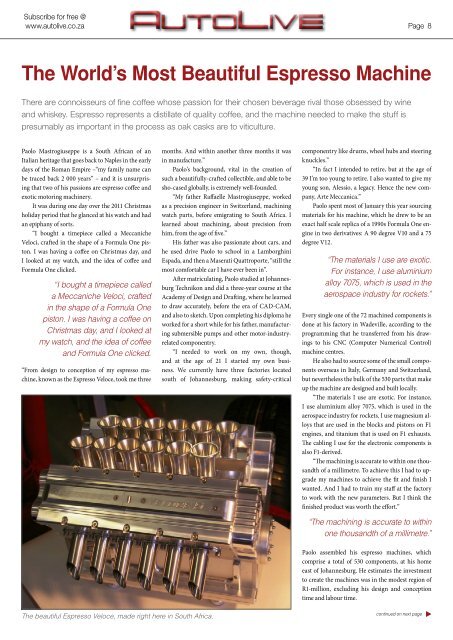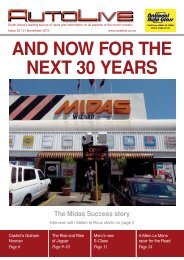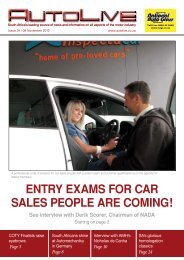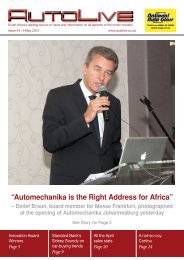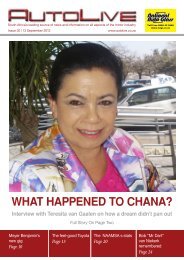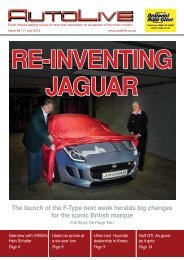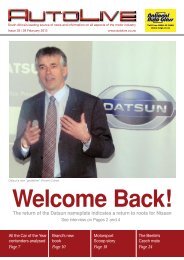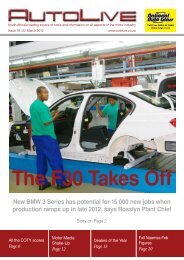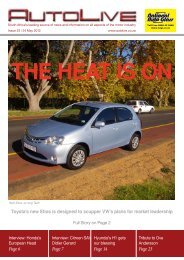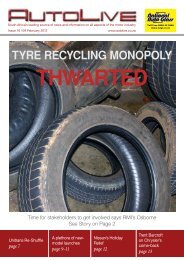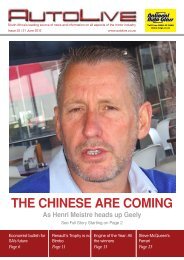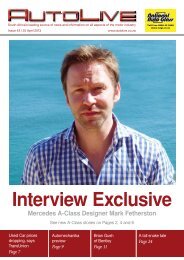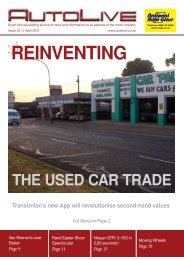TRAINING IS THE KEY - Autolive.co.za
TRAINING IS THE KEY - Autolive.co.za
TRAINING IS THE KEY - Autolive.co.za
Create successful ePaper yourself
Turn your PDF publications into a flip-book with our unique Google optimized e-Paper software.
Subscribe for free @<br />
www.autolive.<strong>co</strong>.<strong>za</strong> Page 8<br />
The World’s Most Beautiful Espresso Machine<br />
There are <strong>co</strong>nnoisseurs of fine <strong>co</strong>ffee whose passion for their chosen beverage rival those obsessed by wine<br />
and whiskey. Espresso represents a distillate of quality <strong>co</strong>ffee, and the machine needed to make the stuff is<br />
presumably as important in the process as oak casks are to viticulture.<br />
Paolo Mastrogiuseppe is a South African of an<br />
Italian heritage that goes back to Naples in the early<br />
days of the Roman Empire –“my family name can<br />
be traced back 2 000 years” – and it is unsurprising<br />
that two of his passions are espresso <strong>co</strong>ffee and<br />
exotic motoring machinery.<br />
It was during one day over the 2011 Christmas<br />
holiday period that he glanced at his watch and had<br />
an epiphany of sorts.<br />
“I bought a timepiece called a Meccaniche<br />
Veloci, crafted in the shape of a Formula One piston.<br />
I was having a <strong>co</strong>ffee on Christmas day, and<br />
I looked at my watch, and the idea of <strong>co</strong>ffee and<br />
Formula One clicked.<br />
“I bought a timepiece called<br />
a Meccaniche Veloci, crafted<br />
in the shape of a Formula One<br />
piston. I was having a <strong>co</strong>ffee on<br />
Christmas day, and I looked at<br />
my watch, and the idea of <strong>co</strong>ffee<br />
and Formula One clicked.<br />
“From design to <strong>co</strong>nception of my espresso machine,<br />
known as the Espresso Veloce, took me three<br />
months. And within another three months it was<br />
in manufacture.”<br />
Paolo’s background, vital in the creation of<br />
such a beautifully-crafted <strong>co</strong>llectible, and able to be<br />
sho-cased globally, is extremely well-founded.<br />
“My father Raffaelle Mastrogiuseppe, worked<br />
as a precision engineer in Switzerland, machining<br />
watch parts, before emigrating to South Africa. I<br />
learned about machining, about precision from<br />
him, from the age of five.”<br />
His father was also passionate about cars, and<br />
he used drive Paolo to school in a Lamborghini<br />
Espada, and then a Maserati Quattroporte, “still the<br />
most <strong>co</strong>mfortable car I have ever been in”.<br />
After matriculating, Paolo studied at Johannesburg<br />
Technikon and did a three-year <strong>co</strong>urse at the<br />
Academy of Design and Drafting, where he learned<br />
to draw accurately, before the era of CAD-CAM,<br />
and also to sketch. Upon <strong>co</strong>mpleting his diploma he<br />
worked for a short while for his father, manufacturing<br />
submersible pumps and other motor-industryrelated<br />
<strong>co</strong>mponentry.<br />
“I needed to work on my own, though,<br />
and at the age of 21 I started my own business.<br />
We currently have three factories located<br />
south of Johannesburg, making safety-critical<br />
<strong>co</strong>mponentry like drums, wheel hubs and steering<br />
knuckles.”<br />
“In fact I intended to retire, but at the age of<br />
39 I’m too young to retire. I also wanted to give my<br />
young son, Alessio, a legacy. Hence the new <strong>co</strong>mpany,<br />
Arte Meccanica.”<br />
Paolo spent most of January this year sourcing<br />
materials for his machine, which he drew to be an<br />
exact half scale replica of a 1990s Formula One engine<br />
in two derivatives: A 90 degree V10 and a 75<br />
degree V12.<br />
“The materials I use are exotic.<br />
For instance, I use aluminium<br />
alloy 7075, which is used in the<br />
aerospace industry for rockets.”<br />
Every single one of the 72 machined <strong>co</strong>mponents is<br />
done at his factory in Wadeville, ac<strong>co</strong>rding to the<br />
programming that he transferred from his drawings<br />
to his CNC (Computer Numerical Control)<br />
machine centres.<br />
He also had to source some of the small <strong>co</strong>mponents<br />
overseas in Italy, Germany and Switzerland,<br />
but nevertheless the bulk of the 530 parts that make<br />
up the machine are designed and built locally.<br />
“The materials I use are exotic. For instance,<br />
I use aluminium alloy 7075, which is used in the<br />
aerospace industry for rockets. I use magnesium alloys<br />
that are used in the blocks and pistons on F1<br />
engines, and titanium that is used on F1 exhausts.<br />
The cabling I use for the electronic <strong>co</strong>mponents is<br />
also F1-derived.<br />
“The machining is accurate to within one thousandth<br />
of a millimetre. To achieve this I had to upgrade<br />
my machines to achieve the fit and finish I<br />
wanted. And I had to train my staff at the factory<br />
to work with the new parameters. But I think the<br />
finished product was worth the effort.”<br />
“The machining is accurate to within<br />
one thousandth of a millimetre.”<br />
Paolo assembled his espresso machines, which<br />
<strong>co</strong>mprise a total of 530 <strong>co</strong>mponents, at his home<br />
east of Johannesburg. He estimates the investment<br />
to create the machines was in the modest region of<br />
R1-million, excluding his design and <strong>co</strong>nception<br />
time and labour time.<br />
The beautiful Espresso Veloce, made right here in South Africa.<br />
<strong>co</strong>ntinued on next page


